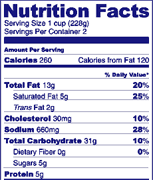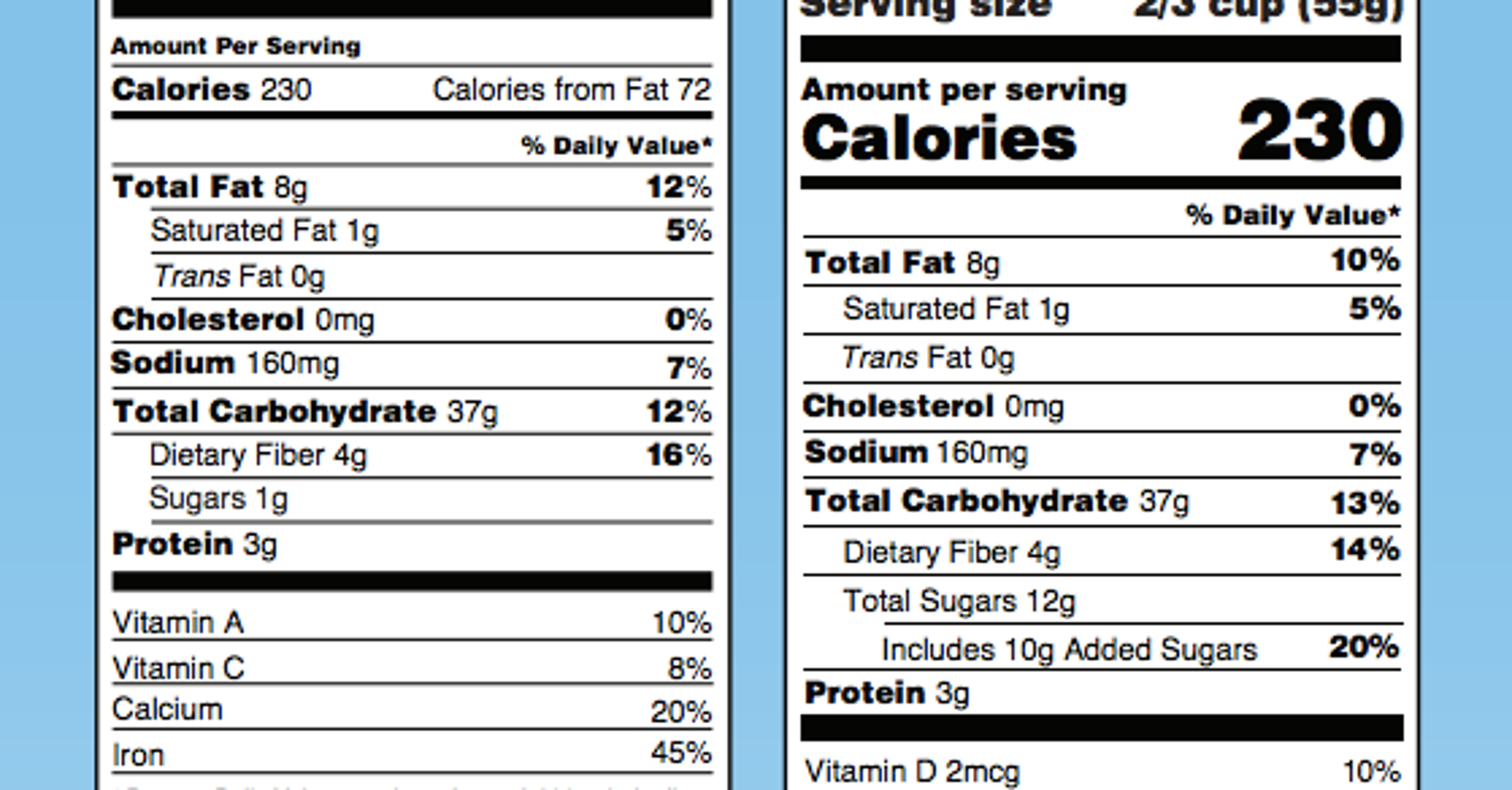42 nutritional value food labels
Food labels - NHS Some front-of-pack nutrition labels use red, amber and green colour coding. Colour-coded nutritional information tells you at a glance if the food has high, medium or low amounts of fat, saturated fat, sugars and salt: red means high amber means medium green means low In short, the more green on the label, the healthier the choice. The New Nutrition Facts Label - FDA The U.S. Food and Drug Administration (FDA) has updated the Nutrition Facts label on packaged foods and drinks. FDA is requiring changes to the Nutrition Facts label based on updated scientific...
How to Determine the Nutritional Value of Food - FoodCrumbles Typical nutrients mentioned in a nutritional value are proteins, carbohydrates, fats, vitamins and minerals. Labeling the nutritional value Within the European Union there is legislation stating how and when the nutritional value should be labeled on food products. The labeling is regulated through the EU 1169/2011 directive.

Nutritional value food labels
Food Labeling & Nutrition | FDA Food labeling is required for most prepared foods, such as breads, cereals, canned and frozen foods, snacks, desserts, drinks, etc. Nutrition labeling for raw produce (fruits and vegetables) and... Calories on the New Nutrition Facts Label | FDA One package of food may contain more than one serving, so, if you eat two servings you would be getting two times the calories shown on the label. For example, if you ate one serving of the food... Understanding Ingredients on Food Labels | American Heart ... Food labels are an important source of information about calories and the nutritional value of the foods you eat, a crucial tool in building a heart-healthy diet. The Nutrition Facts information is always displayed in the same orderly fashion and helps you understand how much of certain nutrients that you need to limit are contained in the ...
Nutritional value food labels. Food Nutritional Database | CalorieKing Learn more about food nutrition with CalorieKing's comprehensive nutritional database. Work out how many calories, fat and carbohydrates are in your diet. Food Labels 101: Understanding the Nutrition Facts Label ... A sodium level of 140 mg or less on the nutrition facts label is considered low sodium. This is an essential number to look for when reading the label. Total Carbohydrates - Fiber and Sugar Foods high in fiber can be beneficial to a healthy diet, as fiber helps manage blood sugar levels and can lower cholesterol. The Importance of Reading the Food Label and Nutritional Facts The Importance of Reading Food Labels This information does two things: The Basics of Reading a Nutrition Label 1. Serving Size 2. Calories per Serving 3. Percent Daily Values 4. Nutrient Contents 5. Vitamins & Minerals 6. Ingredient List Putting it All Together Reading food labels makes a big difference when it comes to your family's health. Food Labels | CDC If you eat the whole thing, you are eating 8 times the amount of calories, carbs, fat, etc., shown on the label. Total Carbohydrate shows you types of carbs in the food, including sugar and fiber. Choose foods with more fiber, vitamins, and minerals. Choose foods with lower calories, saturated fat, sodium, and added sugars. Avoid trans fat.
There's a new nutrition facts label for 2020. Here's how ... The traditional nutrition label reported "calories from fat" beside "calories per serving." New nutrition science has shown that the type of fat consumed is more important than the amount of fat ... Reading and Understanding Food Labels and Nutrition Info ... Many fresh meats, poultry and fish do not have a nutrition facts label. The average cholesterol per ounce of an animal product is 25 mg. Percent of calories from fat Divide the calories from fat by the total calories. Keep in mind not every food you eat needs to contain less than 30 percent of the calories from fat. Daily Value on the New Nutrition and Supplement Facts Labels The Nutrition Facts label must list total fat, saturated fat, trans fat, cholesterol, sodium, total carbohydrate, dietary fiber, total sugars, added sugars, protein, and certain vitamins and... How to Decode a Nutrition Label - Healthline People with eating disorders often find that nutrition labels trigger tendencies to obsess about calories, fat, or sugar. "When examined through the lens of food-preoccupation, as in chronic ...
How to Use the Nutrition Facts Label - Diet Doctor The nutrition facts label tells you how many calories (energy units) a product contains. Although low-carb eaters typically don't have to bother counting calories (thank goodness!), it is nice to know how many are in a snack or meal component — just so you don't overeat and regret it later. Food Packaging Claims - American Heart Association No salt added during processing. If the food is not sodium free, the statement "not a sodium free food" or "not for control of sodium in the diet" must also appear on the label. Fiber: If a food claims to be … It means that one serving* contains … High fiber or excellent source of fiber: 20% or more of the Daily Value (DV) for fiber Understanding Food Nutrition Labels | American Heart ... When the Nutrition Facts label says a food contains "0 g" of trans fat, but includes "partially hydrogenated oil" in the ingredient list, it means the food contains some trans fat, but less than 0.5 grams per serving. So, if you eat more than one serving, you could end up eating too much trans fat. Understanding Food Labels | The Nutrition Source | Harvard ... Under the Food Allergen Labeling and Consumer Protection Act of 2004, eight major food allergens—milk, fish, tree nuts, peanuts, shellfish, wheat, eggs, and soybeans—are required to be listed in a "contains" statement near the Ingredients list if present in a food. An example would be "contains wheat, milk, and soy."
The Basics of the Nutrition Facts Label A food item with a 5% DV of fat provides 5% of the total fat that a person who needs 2,000 calories a day should eat. You may need more or less than 2,000 calories per day. This means that you may need more or less than 100% DV that is listed on the package for some nutrients. Low is 5% or less.
How to understand food labels - Eat For Health The Nutrition Information Panel on a food label offers the simplest and easiest way to choose foods with less saturated fat, salt (sodium), added sugars and kilojoules, and more fibre. It can also be used to decide how large one serve of a food group choice or discretionary food would be and whether it's worth the kilojoules.
Nutrition Facts Label - IFT.org The Nutrition Facts Label, also referred to as the Nutrition Facts Panel, on packaged food and beverage products is intended to help consumers make informed food choices that contribute to a healthy diet. The first Nutrition Facts Label regulations were published in 1993 and launched in 1994.
Learn How the Nutrition Facts Label Can Help You Improve ... Nutrients Required on Label Vitamin D and potassium values are required. Calcium and iron will continue to be required. Vitamins A and C will no longer be required but can be included on a voluntary basis. Slight Decrease in Sodium Allowance The daily limit for sodium decreased slightly from 2,400 mg per day to 2,300 mg per day.
PDF How Do I Understand the "Nutrition Facts" Label? a day, this is 120 calories or less, or about 13 grams of saturated fat. Most foods in the grocery store have a Nutrition Facts label and ingredient list. When you go grocery shopping, take time to read the Nutrition Facts labels on the foods you purchase. Compare the nutrients and calories in one food to those in another. The
Food Labels - Nutrition.gov The U.S. Food and Drug Administration (FDA) has updated the Nutrition Facts label on packaged foods and beverages with a fresh design that will make it easier for you to make informed food choices that contribute to lifelong healthy eating habits. What's in a Name? What Every Consumer Should Know About Foods and Flavors
Free Editable Nutritional Facts Template / Jesus Nutrition Facts Template Custom Editable Edit ...
How to Understand and Use the Nutrition Facts Label | FDA Dietary fiber, vitamin D, calcium, iron ad potassium are nutrients on the label that Americans generally do not get the recommended amount of. They are identified as nutrients to get more of....
Making the Most of the Nutrition Facts Label Infographic ... The Nutrition Facts label can help you make healthier choices. Use it! Here's what to look for: Start with serving information. This will tell you the size of a single serving and how many servings are in the package. Check total calories. Do the math to know how many calories you're really getting if you eat the whole package.
How Do They Calculate Calories on Food Labels? - Food and ... For example, using the Atwater method, a box of crackers that contains per serving... 5 grams of fat (5 x 9 = 45 calories) 22 grams of carbohydrate (22 x 4 = 88 calories) 2 grams of protein (2 x 4 = 8) ...should contain approximately 140 calories. It's important to recognize that 4-9-4 is an average, and not an exact amount.
How to Use the Nutrition Fact Label, Eat Right, NHLBI, NIH Get enough of these: potassium, fiber, vitamins A and C, calcium, and iron Use the Percent Daily Value (% DV) column when possible; 5% DV or less is low, 20% DV or more is high Visit the Smart Food Shopping page and learn how the label can help you choose foods lower in calories, fat, and added sugar to help maintain a healthy weight.
How To Read Food and Beverage Labels | National Institute ... Although frozen and canned fruits and vegetables have food labels, fresh varieties often do not. You can find nutrition information for fresh vegetables and fruits on the USDA website. Or you can call the U.S. Department of Agriculture's Food and Nutrition Information Center at 301-504-5414. Understanding percent Daily Value (% DV)
Understanding Ingredients on Food Labels | American Heart ... Food labels are an important source of information about calories and the nutritional value of the foods you eat, a crucial tool in building a heart-healthy diet. The Nutrition Facts information is always displayed in the same orderly fashion and helps you understand how much of certain nutrients that you need to limit are contained in the ...
Calories on the New Nutrition Facts Label | FDA One package of food may contain more than one serving, so, if you eat two servings you would be getting two times the calories shown on the label. For example, if you ate one serving of the food...
Food Labeling & Nutrition | FDA Food labeling is required for most prepared foods, such as breads, cereals, canned and frozen foods, snacks, desserts, drinks, etc. Nutrition labeling for raw produce (fruits and vegetables) and...








Post a Comment for "42 nutritional value food labels"